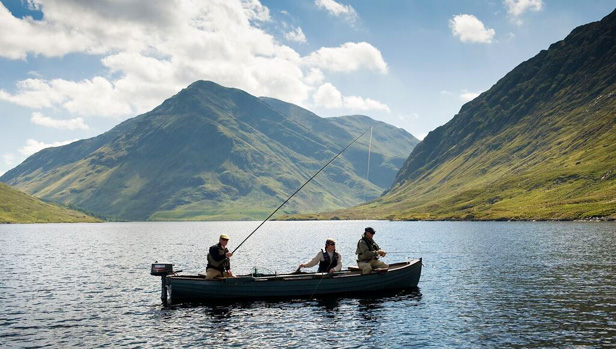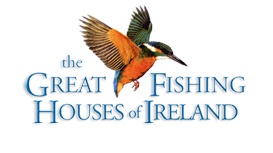

The Loughs
Lough Mask
Located in the South of Co Mayo
Permission: Free
Mask is a limestone lough of some 20,000 acres, and 10 miles long by about 4 miles wide. It is noted for its beautiful free-rising brown trout. The average size is 1 lb 3 oz but 3 lb fish are common and it holds a big stock of ferox trout to over 20 lb. These big fish are taken by trolling in depths from 10 to 30 feet, usually around the islands in the middle of the lough. The area in question stretches from Carrigeendauv in the north to Ram’s island in the south. There is excellent wet-fly fishing, and dapping the mayfly in late May and June is most productive. Dapping the natural grasshopper takes a lot of good fish in August – September. Dry fly fishing with a lightly dressed Green Drake works well when the trout are feeding on mayfly and shore fishing is possible in a number of places. One such place is the mouth of the canal, where dry sedges are fished off the shore, and Olive Spinners will take good trout in the summer evenings along many of the bays on the eastern shore. There are good hatches of chironomids from early April and later in that month the lake olives appear and continue into early May. Popular wet-fly patterns at this time are Fiery Brown, Sooty Olive, Blae Sooty Olive, Black Pennell, Connemara Black, Peter Ross, Watson’s Fancy, Greenwell’s Glory, Mallard and Claret and Cock Robin. The Mayfly dominate the fishing from mid-May to late in June and dapping mayfly and yellow mayfly patterns work well; the Invicta, Teal and Yellow and Golden Olive are also useful, there is good night buzzer fishing. Trout fishing slows down in July but picks up again in August and September. The best killing patterns from August onwards are Claret Murrough, Green Peter, Bibio, Watson’s Fancy, Invicta, Daddy, Golden Olive, Peter Ross and Black and Peacock Spider.
Mask offers the angler enormous variety with vast areas of productive water. To help the angler find the best fishing grounds, the following is a guided tour of the lough, starting at Cushlough Bay and working north in an anticlockwise direction.
Cushlough Bay: Cushlough Bay is shallow and its heavy weed growth in summer makes fishing difficult. It holds a good stock of trout and has hatches of duckfly, olives and sedges. It offers particularly good Buzzer fishing at dusk in May and June.
Carrigeennawalla Island, Castle Hag Island, and across to river mouth: There are extensive shallows in all of this area with good mayfly and sedge hatches and a sparse olive hatch.
Burnthouse Bay: There are some nice deep holes holding flood trout. Fish along both shores and around the rocks. The dap can pull a big trout in any of the inner corners.
Farragher’s (Keel) Bay: Start drifting well out in the lough in a south-west wind. It fishes best along either shoreline.
Golden Bay: This bay has good olive and mayfly hatches. It is shallow and fishes best in a north or south-west wind, starting at least ½ mile out in the lough.
Ram’s Horn Bay: There are extensive fishing shallows outside the bay and there are two good drifts inside where the dap can work particularly well in August and September.
Lively Bay: This bay does not always live up to its name. There are extensive fishing shallows outside the bay and the bay itself is then fished in and around to the right.
The Rocky Shore: This is the vast area of shallows and rocks stretching from Lively Bay to Ballygarry Bay. It has good hatches of mayfly, olives and sedges and can be fished with wet fly of dap.
Ballygarry Bay: Access from the main lough is from the west and around by the headland, rather than from the south. It is dotted with islands and reefs. It has olives, chironomids, mayfly and sedges. It is an ideal place for fishing dry Buzzers and Olive Spinners in the evening. The open water can be fished with wer fly, and dapping the grasshopper in autumn is frequently very productive.
Bay of Islands (also known locally as Tra na Greine): There is really excellent trout fishing available all over this vast area at all times in the season. It holds an excellent stock of very big trout and tactics vary from buzzer pupai to dapped grasshoppers.
Mouth of Cloon River: The fishing is limited and the drifts are close to both shores down to the mouth of the river.
Tourmakeady to Annagh Point: There is about 4 miles of shoreline fishing here and the drifts are easiest in a south-west or north-east wind. It is a comparatively safe area and free of rocks but very exposed in a strong wind. It holds very good stocks of trout and the mayfly hatch is generally a week later than on the east side of the lough.
Annagh Point to Foxhill Point and Maamtrasna Bay: There is good fishing in all of this area but the fishing on the south shore of the bay is very close to the shore.
Kilbride Shore: There is good fishing off the shore and around the islands and there is a mayfly hatch.
Upper Mask Bay: Upper Mask is really a lough in its own right, being almost completely cut off from the main lough at the Ferry Bridge. It is over 4 miles long and too deep up the middle for trout fishing, most of which is done at the Ferry Bridge end and around the islands. It holds an excellent stock of trout that rise well during duckfly, mayfly and sedge hatches. There are several boats for hire at the Ferry Bridge.
Ferry Bridge to Big (Red) Island: The fishing is mainly along the shore. This area has an excellent mayfly hatch and fishes best in a west or north-west wind.
Roshill Bay: The fishing is very limited and the water is too low in summer.
White Island to Inishgleasty: This area offers really excellent trout fishing. There is a good hatch of duckfly off the south point of Inishgleasty and trout concentrate in big numbers in this area in April. The bays along the shore are very good for the dap.
Dringeen Bay: This bay holds a stock of large trout. It gets cut off from the main lough in summer. It is noted for its good shore fishing – with local permission – on summer evenings.
Inishgleasty to the mouth of the canal: Excellent fishing with good sedge and mayfly hatches. This area is noted for its big trout. Bank fishing to trout feeding on sedges and olive spinners is very popular. An 18 lb trout was taken here by an angler spinning off the shore.
The Cuts: These are long, narrow rocky bays to the south-east of Inishowen. They are only the width of a drifting boat in some places and can best be fished in a south wind. Great places for big trout to either wet fly or dap.
Castle Bay: This bay lies to the north of the mouth of the canal but is inaccessible by boat from the main lough in summer. It holds very good trout.
Inishowen: The shallows extend to the west and south. This whole area offers really excellent wet fly fishing and has a good mayfly hatch.
Caher Bay: This bay is noted for its wet fly fishing and dapping. There is a small bay to the north of Lamb’s Island that gets a great rise of trout to buzzers and olives on summer evenings.
Ballinchalla Bay (also called Ballahalla Bay): This is a large, shallow bay to the south-east of Caher Bay. It gets a great hatch of olives in April and the fish appear to migrate into the bay to feed on them. There is frequently excellent fishing at this time which anglers do not always take advantage of. It again provides great buzzer fishing late in the evening in May and June. It does not have a mayfly hatch.
Lamb’s Island to Curramore Point: All of this area, and out to Martin’s Island and beyond to Rialisk, is a mass of fishing shallows.
Ram’s Island: Fish along both shores; there is a mayfly hatch.
Corrigeenagur: The best fishing is along both shores. There is a mayfly hatch.
Corrigeennaweelaun: Fish along the shore and the shallows around.
Inishowel north to Devenish: This is a vast fishing area, nearly 3 miles long by 1 mile wide. There is an island and shallows to the west of Inishowel and to the south-west and north. Then continue fishing all the way up to Shintilla and to the west of Devenish as far as the Black Rocks.
Inishoght: There is excellent fishing along both shores and on the shallows to the west. This is a great area for mayfly fishing.
Carrigeendavoe: The fishing along both shorelines is very good. There are good shallows to the north. This is an area where the angler will always rise a fish even when the fishing is quiet in other areas.
Carrigeendauv: Fish along both shores. The 30 foot contour around this island is a noted place for taking a big ferox trout.
Ballinrobe is the major angling centre for Mask, but anglers also stay at Cushlough, Partry, Srah, Tourmakeady, Tream, Ferry Bridge, Clonbur and Ballinchalla. Access to the lough is very good with safe moorings and slipways in most areas. The chief points of access are Cushlough – where there is a large car park, anglers’ shelter, public toilets and a number of excellent guest houses, Cahir Bay, Ballinchalla Bay, Roshill, Ferry Bridge, Annagh, Churchfield, Tourmakeady, Srah, Ballygarry and Aughinish. Anglers should check, as local permission is required at some of the above. A limited number of boats and boatmen are available for hire right around the lough. Mask is a dangerous place with extensive reefs, capable of splitting a boat wide open, lying just under the surface, and the new-comer to Mask would be well advised to avail himself of the services of an experienced boatman. There is another factor that visitors should bear in mind and that is that the level of the lough varies by as much as 8 feet from summer level to winter. The Western Fisheries Board has a development and information centre at Cughlough. There is a statutory 12-inch size limit for trout on the lough.
Excerpts taken from "Trout & Salmon Rivers of Ireland, an angler's guide" by Peter O'Reilly.

